Two SpeedBrake reviews
Diesel World/Trailer Life September 2009
The Banks SpeedBrake is reviewed in Diesel World and in Trailer Life. (on a 2008 Chevy 2500HD then a 2006 Chevy Silverado).



Note: The PowerPDA used for this article
has now been upgraded to the new Banks iQ.
Diesel technology has continued to evolve. Gone are the days of mechanical injection, and now a computer controls the cycles of high-pressure injectors down to the millisecond. Horsepower, torque and mileage numbers are up, while emissions emitted from the tailpipe and engine noise are down. It’s a brave new world from the days of IDI. With the engine improvements comes a new breed of aftermarket parts designed to take full advantage of the latest diesel powerplants.
Take, for example, exhaust brakes, which were designed to save brakes and make towing safer and easier. In the past, the installation included cutting and welding a flap apparatus into place. Getting all the plumbing and hardware set up was a solid day job for a professional, and could take the better portion of a weekend for the novice. If you own a 2004.5-to- 2009 Duramax pickup, though, you could get all of the benefits of an exhaust brake and then some without having to break out the welder. Actually, all you really need are basic hand tools.
The new SpeedBrake from Gale Banks Engineering is the latest in all-electronic exhaust brakes, with plug-and-play connections for a clean and simple installation, and no cutting or tapping required. It’s a feature-packed brake different from other exhaust brakes on the market. Not only does it increase the stopping power and extend the service life of brakes, its adjustable, maintenance-free and also capable of reading and cleaning the computer of codes.
Utilizing the factory VGT turbocharger on the Duramax, the SpeedBrake captures control of the varying vane position. Instead of closing a flap like traditional exhaust brakes, the SpeedBrake closes the vanes on the turbocharger to create backpressure. The SpeedBrake also takes charge of torque converter lockup and transmission gear selection to aid in the deceleration process. Meanwhile, the PowerPDA gives the driver feedback on important engine parameters and user-set on-screen alerts.
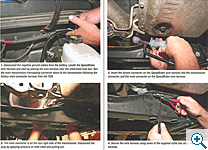 We followed the install of the SpeedBrake into an ‘08 Chevy 25OOHD back at the Banks headquarters in Azusa, Calif. In less than 90 minutes, the truck was on the road with the SpeedBrake up and running. It was a painless process that produced some serious results when the truck was loaded with more than 10,000 pounds-worth of trailer and taken for a test-drive, all with barely getting the installer’s hands dirty.
We followed the install of the SpeedBrake into an ‘08 Chevy 25OOHD back at the Banks headquarters in Azusa, Calif. In less than 90 minutes, the truck was on the road with the SpeedBrake up and running. It was a painless process that produced some serious results when the truck was loaded with more than 10,000 pounds-worth of trailer and taken for a test-drive, all with barely getting the installer’s hands dirty.
While we have the scientific results in the sidebar (see below), we carried our own impressions of the SpeedBrake separate from strictly numbers. The thing that impressed us most about the SpeedBrake was the Speed Control feature. Think of speed control as cruise control of sorts, but instead of controlling acceleration, it controls deceleration.
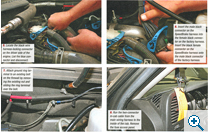 Coming down Southern California’s Cajon Pass fully loaded and with the Speed Control set at 55, the SpeedBrake took advantage of the VGT turbo, closing the vanes at just the right amount needed to maintain the preset speed. It was as quiet as it was smooth, while the speedometer didn’t deviate from our desired cruising speed. Its smoothness is what really impressed us. Even on steep sections of the pass, the transmission didn’t have to downshift once the initial set speed was obtained.
Coming down Southern California’s Cajon Pass fully loaded and with the Speed Control set at 55, the SpeedBrake took advantage of the VGT turbo, closing the vanes at just the right amount needed to maintain the preset speed. It was as quiet as it was smooth, while the speedometer didn’t deviate from our desired cruising speed. Its smoothness is what really impressed us. Even on steep sections of the pass, the transmission didn’t have to downshift once the initial set speed was obtained.
The other shining point was the adjustability of the SpeedBrake from the PowerPDA. With the touch of a screen, the aggressiveness of the braking could be changed to low, medium or high. The high mode is slam-you-forward hard, as the transmission downshifts in a hurry to bring you to a quick halt. Under fairly light loads, it was almost too much. But throw some serious weight behind the truck, and the aggressiveness was welcomed when it came time to bringing the truck to a stop.
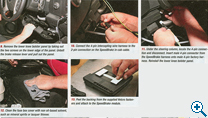 Along with the level settings, the other thing that stands out was the adjustability on how the SpeedBrake was activated. You have the option to allow the SpeedBrake to control itself and act like a traditional exhaust brake where it engages on deceleration, or you could activate it through the brake pedal.
Along with the level settings, the other thing that stands out was the adjustability on how the SpeedBrake was activated. You have the option to allow the SpeedBrake to control itself and act like a traditional exhaust brake where it engages on deceleration, or you could activate it through the brake pedal.
The SpeedBrake is electronic and basically knows everything going on in the factory computer relevant to its operation. When you activate it through the brake pedal, you can push the pedal slightly and the SpeedBrake does its thing, creating backpressure and downshifting while enabling the truck to stop. We liked it enough that when the truck is empty, the SpeedBrake is set to activate via the pedal on medium strength, saving some wear on the brake pads in the process.
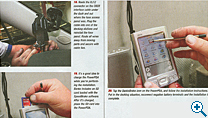 Overall, we think Banks Engineering has hit a homerun with the SpeedBrake. It’s a snap to install, is extremely effective and the adjustability allows the driver to tailor it to his or her preference. If you’re in the market for an exhaust brake for your 2004.5-to-2009 Chevrolet or GMC, it’s definitely worth consideration.
Overall, we think Banks Engineering has hit a homerun with the SpeedBrake. It’s a snap to install, is extremely effective and the adjustability allows the driver to tailor it to his or her preference. If you’re in the market for an exhaust brake for your 2004.5-to-2009 Chevrolet or GMC, it’s definitely worth consideration.
TECH
Testing the Banks Speedbrake
 We hooked up a weighted trailer to the LMM-powered 2500HD, and brought the gross combined weight (GWC) to about 18,500 pounds. With trailer in tow, we headed to a desolate strip of road off California Hwy. 138 where we found a 1-mile strip with a 6.16-percent grade. We hooked up a weighted trailer to the LMM-powered 2500HD, and brought the gross combined weight (GWC) to about 18,500 pounds. With trailer in tow, we headed to a desolate strip of road off California Hwy. 138 where we found a 1-mile strip with a 6.16-percent grade. As the vehicle crested the top of the hill, speed was maintained at 55 mph, with drive as the selected gear. As needed to maintain a constant speed, the driver lifted off the accelerator pedal, which determines the beginning of the test. All tests were conducted with the Tow/Haul mode active. The foot brake was purposely not applied during descent, except to prevent unsafe speeds and runaway conditions. Speed was noted at the end of the run using a GPS-based data acquisition system. When the vehicle is in drive with the Tow/Haul mode active, the approach conditions to the test hill resulted in a fifth-gear selection. In stock condition, as the vehicle descended the hill, it immediately began to accelerate. With no application of the footbrake, the factory electronics allow for an upshift to sixth gear at 63 mph. This occurred 1,150 feet into the run. After traveling 2,400 feet, vehicle speed exceeded 70 mph. To maintain safety, the driver applied the foot brake and slowed the vehicle to 68 mph. At this point, the Tow/Haul mode strategy took over and shifted the transmission to fourth gear. Vehicle speed still increased and reached 69 mph by 3,400 feet. The foot brake was again applied and vehicle speed slowed to 65 mph. At this point, the Tow/Haul strategy allowed for a downshift to third gear. This allowed for vehicle speed to be maintained at about 65 mph for the duration of the run. 1,000-foot speed = 62 mph The first test of the Speedbrake was performed in the speed control mode with a set target speed of 50 mph. As with the previous runs, the vehicle started the descent in fifth gear. But, as soon as the driver lifted his foot from the accelerator, the SpeedBrake began braking activity by closing the turbine vanes and downshifting the transmission to third gear. After travelling 1,400 feet, the vehicle had been slowed to its target speed of 50 mph. Once the target speed was achieved, the Speedbrake varies the position of the turbine vanes such that such speed was maintained at 50 mph for the duration of the run. 1,000-foot speed = 53.6 mph The next test of the SpeedBrake was performed in the Brake ON mode with the strength setting on high. This evaluates the SpeedBrake’s maximum braking capability. As in all the previous runs, the test began with the vehicle in fifth gear. Like the previous run while in speed control mode, the transmission was shifted into third and the truck quickly decelerated. But the since the ON mode dose not have a target speed, the vehicle continued to decelerate and shifted clear down to first gear. After traveling 4.175 feet, the vehicle was slowed to 15 mph for a speed reduction of 40 mph. 1,000-foot speed = 53.6 mph 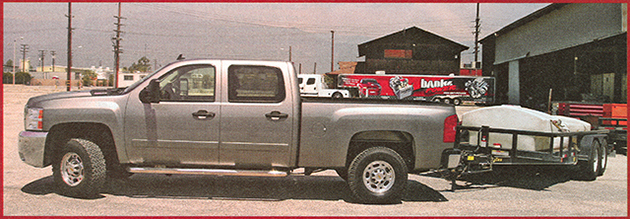 |
TECH
Understanding VGT Turbos and the SpeedBrake
| The latest LMM Duramax uses the Garrett VGT turbocharger.
Variable Turbine Technology (VGT) is the latest in turbocharger technology, and variations are being used on the newest diesels. Because of the large displacement and requirements for air, engines like the 6.6L Duramax require large turbochargers. The bigger the turbo, the more exhaust pressure required to spool it, which creates a problem at lower engine speeds.
At lower engine speeds, the vanes are closed, or close to it, which creates a narrow passage, accelerating the exhaust gas and directing them as they hit the blades of the turbine. As RPMs rise, more exhaust gas is generated, and the vanes begin to open up now that the engine is producing enough exhaust gas to spool the turbo. The result is the characteristics of a smaller turbo at lower engine speeds with enough flow to support the demands of larger, more powerful engines. A computer that takes in data from the sensors, and adjusts the vanes accordingly, controls the actuator that closes and opens the vanes on a VGT engine.
Because a VGT turbocharger has vanes open and closed by a computer-controlled actuator, they can move at any time when given the command. Rather than have a flap, the SpeedBrake shuts the vanes on deceleration, essentially creating the same effect as a flap placed in the exhaust stream. Because it do it through computer manipulation, the system can be controlled with a module and a plug rather than having to weld in an actuated flap. |
Visit Diesel World magazine online!
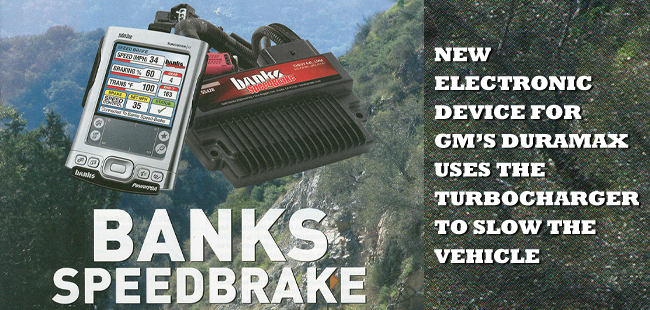
By Ken Freund
In recent years the diesel engines used in pickups have changed significantly, becoming cleaner, quieter and more powerful. Yet with all these changes, diesels still don’t provide much engine braking to help slow the vehicle. Unlike gasoline engines, diesels lack a throttle valve, so when the vehicle is decelerating there is little resistance to the load pushing against the engine’s internal resistance to turning.
This can result in some white-knuckle moments when towing a heavy trailer down a steep grade. Until now, the aftermarket responded with exhaust brakes, which use a closable restriction valve mounted in the exhaust system downstream of the turbocharger to provide more engine braking.
In the middle of the 2004 model year, GM introduced a variable geometry turbocharger (VGT) on the Duramax (LLY version) turbodiesel engine; this system allows electronic control of the vanes within the turbo, effectively increasing or decreasing the size of the exhaust outlet. The factory designed the VGT to close the turbo vanes when exhaust flow is low during initial acceleration. This results in a higher turbine speed, which creates a quicker response time, effectively reducing turbo lag.
Gale Banks Engineering utilized the capabilities of the VGT in combination with additional electronic control of the transmission to produce its new SpeedBrake, which creates a major improvement in engine-braking performance. SpeedBrake, which is designed only for 2004 and newer Chevrolet and GMC pickups with the Duramax diesel engine, is an electronic device that interfaces with the truck’s electronic control module (ECM), the transmission, the VGT and the driver through a vehicle-user interface (VUI). When engine braking is needed, the SpeedBrake takes command of the torque-converter clutch, gear selection and vane position in the turbocharger to produce the desired braking effect. Locking the torque converter eliminates slippage, so all the braking effect produced by the engine is transferred to the drive wheels. No installation of a valve in the exhaust system is required.

These trucks come with an Allison transmission that includes a feature called Automatic Grade Braking (AGB), which monitors throttle position, brake application and speed and automatically selects a lower gear when appropriate. In stock configuration, this results in a higher engine speed and a slight increase in engine braking, but the AGB effectively does little more than provide an automated downshift and a side effect is relatively high engine speeds. GM specifications indicate the Duramax can rev to 4,800 rpm before valve float occurs; however, speeds above 3,900 rpm can be disconcerting to the driver.
With the SpeedBrake, VGT vane position can be set to achieve a desired increase in exhaust backpressure. Banks engineers designed the SpeedBrake to select the best gear without causing excessive engine revs, and chose 3,800 rpm as the maximum allowable target – well below the factory maximum.
The Vehicle User Interface (VUI) provides communication between the user and vehicle. During normal operation, the VUI will display vehicle speed, vane position, transmission temperature, engine-coolant temperature, operating gear, braking mode, target speed and system status. A menu allows for a variety of adjustment selections.
The driver has the option of setting warning alerts if either coolant or transmission temperature exceed a preset value. A status indicator will also communicate any faults that may be detected, allowing for quick and easy troubleshooting.
Unlike traditional exhaust brakes, which are on or off, the SpeedBrake has a nearly infinite range of settings so it can be used as a downhill “cruise control.” You can input your desired speed on the VUI, and SpeedBrake maintains the target speed. SpeedBrake first locks the torque converter, then downshifts the transmission until an appropriate gear is selected. Next, the VGT vanes are closed until vehicle speed reaches the established target. Once speed has stabilized, vane angle will vary as needed to maintain vehicle speed within o. mph of its setting. Target speeds between 25 and 75 mph can be selected, or the unit may be used to provide maximum braking without a target speed.
Installation typically takes less than two hours. The electronic module is mounted in the engine compartment, and a few plug- in connections are made; there isn’t any splicing or cutting into factory wiring. The VUI mounts in a location of the driver’s preference and the OBDII system is accessed by plugging into the under-dash diagnostic connector.
The SpeedBrake can be operated in one of two modes, selectable on the VUI. The “On” mode will activate all available braking features, attempting to slow the vehicle as much as possible. This mode is available down to 15mph. The “Speed Control” mode lets the driver select a target speed and SpeedBrake will work to decelerate to that speed and then maintain it.
While in the “On” mode, three strength selections are available to allow for variations in vehicle weight and user preference. The “High” setting allows the highest level of braking activity by aggressively downshifting the transmission and is recommended for heavily loaded vehicles or when strong braking is desired. The “Medium” setting achieves a moderate level of braking by slightly delaying transmission downshifts and is recommended for moderately loaded vehicles. The “Low” setting gives a lower level of braking activity and is recommended for lightly loaded or unloaded vehicles and stop-and-go driving.
 SpeedBrake can also serve as an OBDII scan tool. If a check engine light should appear on the dash, the user can utilize the SpeedBrake to read, interpret and clear any codes.
SpeedBrake can also serve as an OBDII scan tool. If a check engine light should appear on the dash, the user can utilize the SpeedBrake to read, interpret and clear any codes.
SpeedBrake also monitors slippery road conditions by comparing front and rear wheel speed. If a significant speed differential is detected, SpeedBrake will automatically disengage and notify the driver to manually apply the brakes. This safety feature is similar to the function of the factory anti-lock braking system.
In 2007, GM updated the Silverado and Sierra trucks, and a new diesel particulate filter (DPF) was added. The updated version of the Duramax engine that includes a DPF is the LMM version. According to Banks, the SpeedBrake functions seamlessly, without interruption to the DPF cleaning process on the new models.
TESTING
To evaluate the SpeedBrake, we ran a series of road tests on a 2006 Chevrolet Silverado 4×4 pickup with a Duramax engine. A location was selected in the San Gabriel Mountains of Southern California, using a section of road that includes a 6.16-percent grade that’s about 1 mile long. This closely approximates most long interstate highway grades, which are designed with maximum 6-percent gradients.
Each test was on the same stretch of road, and starting speed for each run was 55 mph. During each trial, the foot brake was not applied unless it was necessary to keep the vehicle at a safe speed.
The vehicle was towing a trailer, bringing combined weight to 18,500 pounds. In this sequence, the tow/haul mode was activated, which also activates the Automatic Grade Braking (AGB) feature.
STOCK
The “stock” baseline test run began at 55 mph, using fifth gear. As I lifted off of the accelerator, the truck accelerated downhill. With no foot-brake application, the factory electronics allow for an upshift to sixth gear when the truck reaches 63 mph. This lowers engine rpm and allows for a greater rate of acceleration. Within less than mile, speed reached an excessive 70 mph, requiring foot-brake application. This activates the AGB, resulting in a downshift from sixth to fifth to fourth in about two seconds. With the rig slowed to 68 mph, I released the foot brake and again accelerated. In less than 1/4-mile, the truck was again at 70 mph, at which time I again applied the foot brake.
The AGB again caused a downshift, this time to third gear, causing engine rpm to reach 3,880rpm. The foot brake was used until speed was down to about 66 mph. After the foot brake was released, the vehicle maintained 65mph for the remainder of the test run while in third gear. It was clear that the vehicle speed cannot be maintained without substantial use of the foot brake in stock condition.
SPEEDBRAKE ON
First, the manual “On” mode (which does not provide speed control) was tested, again with an initial speed of 55 mph in fifth gear. As soon as the accelerator was released, SpeedBrake locked the torque converter clutch, then initiated a downshift sequence to third gear, bringing engine rpm to 3,400. With the turbine vanes closed to generate backpressure, within 5-1/2 seconds the truck was slowing down. By the 1/4-mile mark, the combo slowed to 50 mph and when speed dropped to 49mph the SpeedBrake determined that it was safe for a downshift to second gear, bringing engine rpm up to 3,800 rpm.
The truck continued to slow, and by the 1/4-mile mark, speed was 34mph (compared to 70 mph stock). When speed dropped to 28 mph, the SpeedBrake down-shifted to first gear, bringing engine rpm to 3,500. Speed continued to drop, clear down to 15 mph. At 15 mph in first gear, factory controls force the torque-converter clutch to unlock to avoid stalling the engine, so SpeedBrake responds by deactivating itself. As a result, the vehicle begins to slowly pick up speed. At 17 mph, the SpeedBrake reactivates, thus establishing a control cycle between 15 and 17 mph. During this entire sequence, the foot brakes were never required nor applied.
SPEED CONTROL MODE
Next we tested “Speed Control” mode with target speed set at 50 mph. As was the case while in the “On” mode, the SpeedBrake locked the torque-converter clutch, then downshifted from fifth to fourth to third, followed by full closure of the turbine vanes. When the target speed of 50 mph was reached, vane position varied to maintain 50 mph and for the remainder of the run; 50 mph was maintained within 1 mph.
BRAKING AWAY
Banks’ SpeedBrake is unlike anything offered by the factory or aftermarket, and it definitely works as claimed. It is obvious that a lot of development work went into this system. Despite its many features, the unit is easy to use, allowing the driver to concentrate on driving. During operation noise is minimal and allows normal conversation. The SpeedBrake’s design adds a margin of safety and protects the engine and wheel brakes. This will help pay for itself in reduced maintenance and wear, particularly when towing, which can be tough on brakes. Suggested retail price for the unit we tested is $1,429, complete with the VUI interface.
Visit Trailer Life magazine online!
Read more about what the SpeedBrake can do for your Duramax:
’04-05 LLY
’06-07 LLY/LBZ
’07-09 LMM

Note: The PowerPDA used for this article
has now been upgraded to the new Banks iQ.


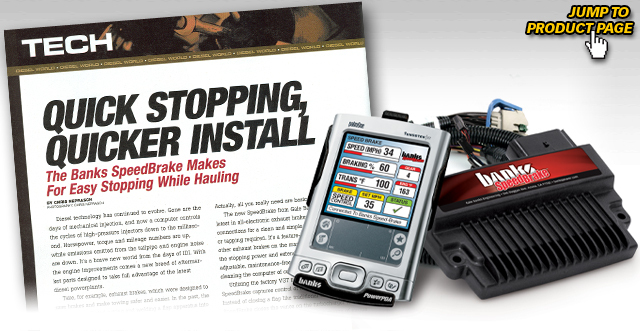
 AVGT turbo has small vanes connected to a actuator that can be moved to direct exhaust flow onto the turbine blades. The vanes are constantly moving open closed based on engine speeds. Vanes on VGT turbochargers aren’t like an old on/off switch; they can be fully open, fully closed, or positioned anywhere in between.
AVGT turbo has small vanes connected to a actuator that can be moved to direct exhaust flow onto the turbine blades. The vanes are constantly moving open closed based on engine speeds. Vanes on VGT turbochargers aren’t like an old on/off switch; they can be fully open, fully closed, or positioned anywhere in between.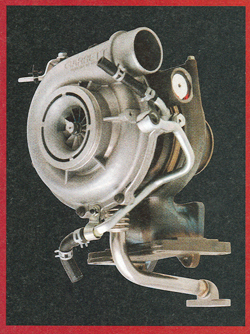 Think about a traditional exhaust brake in its simplest form. A flap is basically in the exhaust stream. When the truck needs to decelerate, the flap closes and the backpressure bottlenecks the exhaust system, which in turn builds pressure upstream from the brake. The pressure acts negative torque, slowing the engine down for a braking effect.
Think about a traditional exhaust brake in its simplest form. A flap is basically in the exhaust stream. When the truck needs to decelerate, the flap closes and the backpressure bottlenecks the exhaust system, which in turn builds pressure upstream from the brake. The pressure acts negative torque, slowing the engine down for a braking effect.